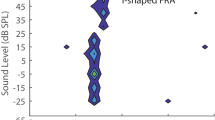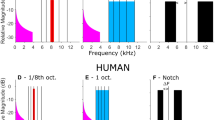Summary
The neuronal response to tones as a function of intensity was topographically studied with multiple-unit recordings in the primary auditory cortex (AI) of barbiturate-anesthetized cats. The spatial distribution of the characteristics of rate/level functions was determined in each of three intensely studied cases and their relationship to the distribution of spectral parameters (sharpness of tuning and responses to broadband transients) in the same animals was determined. The growth of the high-intensity portion of rate/level functions was estimated by linear regression. Locations with monotonically growing high-intensity portions were spatially segregated from locations with nonmonotonic rate/level functions. Two noncontiguous areas with a high degree of non-monotonicity were observed. One was located at the dorsoventral center of AI, and a second in the dorsal third of AI. The more ventral aggregate of high non-monotonicity coincided with the region of sharp frequency tuning. The stimulus levels that produced the highest firing rate (strongest response level, SRL) at any sampled location ranged from 10 to 80 dB sound pressure level (SPL). Several spatial aggregates with either high or low SRLs were observed in AI. The region of sharpest tuning was always associated with a region of low SRLs. The response threshold to contralateral tones at the characteristic frequency (CF) ranged from — 10 dB SPL to 85 dB SPL with the majority between 0 and 40 dB SPL. The spatial distribution of response thresholds indicated several segregated areas containing clusters with either higher or lower response thresholds. The correlation of response threshold with integrated bandwidth and transient responses was only weak. Low- and high-intensity tones of the same frequency are represented at different locations in AI as judged by the amount of evoked neuronal activity and are largely independent of the frequency organization. The spatial distribution of locations with high monotonicity and low strongest response levels were aligned with the organization of the integrated excitatory bandwidth and covaried with the response strength to broadband stimuli.
Similar content being viewed by others
References
Andersen RA, Knight PL, Merzenich MM (1980) The thalamocortical and corticothalamic connections of AI, AII and the anterior auditory field (AAF) in the cat: evidence for two largely segregated systems of connections. J Comp Neurol 194: 663–701
Brandner S, Redis H (1990) The projection from the medial geniculate to field AI in cat: organization in the isofrequency dimension. J Neurosci 10: 50–61
Brugge JF, Merzenich MM (1973) Responses of neurons in auditory cortex of the macaque monkey to monaural and binaural stimulation. J Neurophysiol 36: 1138–1159
Brugge JF, Dubrovsky NA, Aitkin LM, Anderson DJ (1969) Sensitivity of single neurons in auditory cortex of cat to binaural tonal stimulation: effect of varying interaural time and intensity. J Neurophysiol 32: 1005–1024
Erulkar SD, Rose JE, Davies PW (1956) Single unit activity in the auditory cortex of the cat. Bull Johns Hopkins Hosp 99: 55–86
Evans EF, Whitfield IC (1964) Classification of unit responses in the auditory cortex of the unanaesthetized and unrestrained cat. J Physiol (Lond) 171: 476–493
Imig TJ, Adrian HO (1977) Binaural columns in the primary field (AI) of auditory cortex. Brain Res 138: 241–257
Imig TJ, Brugge JF (1978) Relationship between binaural interaction columns and commissural connections of the primary auditory field (AI) in the cat. J Comp Neurol 182: 637–660
Imig TJ, Morel A (1984) Topographic and cytoarchitectonic organization of thalamic neurons related to their targets in low-,middle-, and high-frequency representations in cat auditory cortex. J Comp Neurol 227: 511–539
Imig TJ, Irons WA, Samson FR (1990) Single-unit selectivity to azimuthal direction and sound pressure level of noise bursts in cat high-frequency primary auditory cortex. J Neurophysiol 63: 1448–1466
Jenkins WM, Merzenich MM (1984) Role of cat primary auditory cortex for sound localization behavior. J Neurophysiol 52: 819–847
Matsubara JA, Phillips DP (1988) Intracortical connections and their physiological correlates in the primary auditory cortex (AI) of the cat. J Comp Neurol 268: 38–48
Mendelson J, Schreiner CE, Grasse K, Sutter ML (1988) Spatial distribution of responses to FM sweeps in cat primary auditory cortex. Assoc Res Otolaryngol Abstr 11: 36
Merzenich MM, Knight P, Roth GL (1975) Representation of the cochlea within the primary auditory cortex in the cat. J Neurophysiol 38: 231–249
Merzenich MM, Schreiner CE, Recanzone G, Beitel R, Sutter (1991) Topographic organization of cortical field AI in the owl monkey (Aotus trivirgatus). Assoc Res Otolaryngol Abstr 14: 44
Metherate R, Ashe JH, Weinberger NM (1990) Acetylcholine modifies neuronal acoustic rate-level functions in guinea pig auditory cortex by an action at muscarinic receptors. Synapse 6: 364–368
Middlebrooks JC, Pettigrew JD (1981) Functional classes of neurons in primary auditory cortex of the cat distinguished by sensitivity to sound location. J Neurosci 1: 107–120
Middlebrooks JC, Zook JM (1983) Intrinsic organization of the cat's medial geniculate body identified by projections to binaural response-specific bands in the primary auditory cortex J Neurosci 3: 203–224
Middlebrooks JC, Dykes RW, Merzenich MM (1980) Binaural response-specific bands in primary auditory cortex (AI) of the cat: topographical organization orthogonal to isofrequency contours. Brain Res 181: 31–48
Morel A, Imig TJ (1987) Thalamic projections to fields A, AI, P, and VP in the cat auditory cortex. J Comp Neurol 265: 119–144
Ojima H, Honda CN, Jones EG (1991) Pattems of axon collateralization of identified supragranular pyramidal neurons in the cat auditory cortex. Cerebral Cortex 1: 80–94
Pfingst BE, O'Connor TA, Miller JM (1977) Single cell activity in the awake monkey cortex: intensity coding. Trans Am Acad Ophtalmol Otularyngol 84: 217–222
Phillips DP (1988) Effects of tone-pulse rise time on rate-level functions of cat auditory cortex neurons: excitatory and inhibitory processes shaping responses to tone onset. J Neurophysiol 59: 1524–1539
Phillips DP (1990) Neural representation of sound amplitude in the auditory cortex: effects of noise amplitude. Behav Brain Res 37: 197–214
Phillips DP, Cynader MS (1985) Some neural mechanisms in the cat's auditory cortex underlying sensitivity to combined tone and wide-spectrum noise stimuli. Hear Res 18: 87–102
Phillips DP, Irvine DRF (1981) Responses of single neurons in physiologically defined primary auditory cortex (AI) of the cat: frequency tuning and responses to intensity. J Neurophysiol 45: 48–58
Phillips DP, Hall SE (1986) Spike-rate intensity functions of cat cortical neurons studied with combined tone-noise stimuli. J Acoust Soc Am 80: 177–187
Phillips DP, Hall SE (1987) Response of single neurons in cat auditory cortex to time-varying stimuli: linear amplitude modulations. Exp Brain Res 67: 479–492
Phillips DP, Orman SS (1984) Responses of single neurons in posterior field of cat auditory cortex to tonal stimulation. J Neurophysiol 51: 147–163
Phillips DP, Hall SE, Hollett JL (1989) Repetition rate and signal level effects on neuronal responses to brief tone pulses in cat auditory cortex. J Acoust Soc Am 85: 2537–2549
Phillips DP, Orman SS, Musicant AD, Wilson GF (1985) Neurons in the cat's primary auditory cortex distinguished by their responses to tones and wide-spectrum noise. Hear Res 18: 73–86
Raggio ME, Schreiner CE, Merzenich MM (1992) Correspondence of functional topographies in cat primary auditory cortex for acoustic and electric cochlear stimulation. Soc Neurosci Abstr 18: 382
Rajan R, Aitkin LM, Irvine DRF (1990) Azimuthal sensitivity of neurons in primary auditory cortex of cats. II. Organization along frequency-band strips. J Neurophysiol 64: 888–902
Reale RA, Imig TJ (1980) Tonotopic organization in cat auditory cortex. J Comp Neurol 192: 265–292
Reale RA, Kettner RE (1986) Topography of binaural organization in primary auditory cortex of the cat: effects of changing interaural intensity. J Neurophysiol 56: 663–682
Reale RA, Imig TJ, Sinex DG (1979) Rate-intensity functions of single neurons located within binaural suppression columns of cat primary auditory cortex. Soc Neurosci Abstr 5: 29
Rose JE (1949) The cellular structure of the auditory area of the cat. J Comp Neurol 91: 409–439
Rouiller EM, Simm GM, Villa AEP, De Ribaupierrre Y, De Ribaupierre F (1991) Auditory corticocortical interconnections in the cat: evidence for parallel and hierarchical arrangement of the auditory coortical areas. Exp Brain Res 86: 483–505
Schreiner CE, Cynader MS (1984) Basic functional organization of second auditory cortical field (AII) of the cat. J Neurophysiol 51: 1284–1305
Schreiner CE, Mendelson JR (1990) Functional topography of cat primary auditory cortex: distribution of integrated excitation. J Neurophysiol 64: 1442–1459
Schreiner CE, JR Mendelson Grasse K, Sutter M (1988) Spatial distribution of basic response properties in cat primary auditory cortex. Assoc Res Otolaryngol Abstr 11: 36
Shamma SA, Fleshman JW (1990) Spectral orientation columns in the primary auditory cortex. Assoc Res Otolaryngol Abstr 13: 222
Suga N (1977) Amplitude-spectrum representation in the Doppler-shifted processing area of the auditory cortex of the mustached bat. Science 196: 64–67
Suga N (1984) The extent to which biosonar information is represented in the bat auditory cortex. In: Edelman GM, Gall WE, Cowan WM (eds) Dynamic aspects of neocortical function. Wiley, New York, pp 315–373
Suga N (1988) Auditory neuroethology and speech processing: complex-sound processing by combination-sensitive neurons. In: Edelman GM, Gall WE, Cowan WM, (eds) Auditory function, neurobiological bases of hearing. Wiley, New York pp679–720
Suga N, Manabe T (1982) Neural basis of amplitude-spectrum representation in the auditory cortex of the mustached bat. J Neurophysiol 47: 225–255
Suga N, Tsuzuki K (1985) Inhibition and level-tolerant frequency tuning in the auditory cortex of the mustached bat. J Neurophysiol 53: 1109–1145
Suga N, Niwa H, Taniguchi I, Margoliash D (1987) The personalized auditory cortex of the mustached bat: adaptation for echolocation. J Neurophysiol 58: 643–654
Sutter ML, Schreiner CE (1991a) Physiology and topography of neurons with multipeaked tuning curves in cat primary auditory cortex. J Neurophysiol 65: 1207–1226
Sutter ML, Schreiner CE (1991b) Topography of intensity encoding by single neurons in cat primary auditory cortex. Soc Neurosci Abstr 17: 1484
Tunturi AR (1952) A difference in the representation of auditory signals for the left and right ears in the iso-frequency contours of the right middle ectosylvian and auditory cortex of the dog. Am J Physiol 168: 712–727
Wallace MN, Bajwa S (1991) Patchy intrinsic connections of the ferret primary auditory cortex. Neuroreport 2: 417–420
Wallace MN, Kitzes LM, Jones EG (1991a) Intrinsic inter- and intralaminar connections and their relationship to the tonotopic map in cat primary auditory cortex. Exp Brain Res 86: 527–544
Wallace MN, Kitzes LM, Jones EG (1991b) Chemoarchitectonic organization of the cat primary auditory cortex. Exp Brain Res 86: 518–526
Winer JA (1984) Anatomy of layer IV in cat primary auditory cortex (AI). J Comp Neurol 224: 535–567
Woolsey CN, Walzl EM (1942) Topical projection of nerve fibers from local regions of the cochlea in the cerebral cortex of the cat. Bull Johns Hopkins Hosp 71: 315–344
Author information
Authors and Affiliations
Rights and permissions
About this article
Cite this article
Schreiner, C.E., Mendelson, J.R. & Sutter, M.L. Functional topography of cat primary auditory cortex: representation of tone intensity. Exp Brain Res 92, 105–122 (1992). https://doi.org/10.1007/BF00230388
Received:
Accepted:
Issue Date:
DOI: https://doi.org/10.1007/BF00230388




